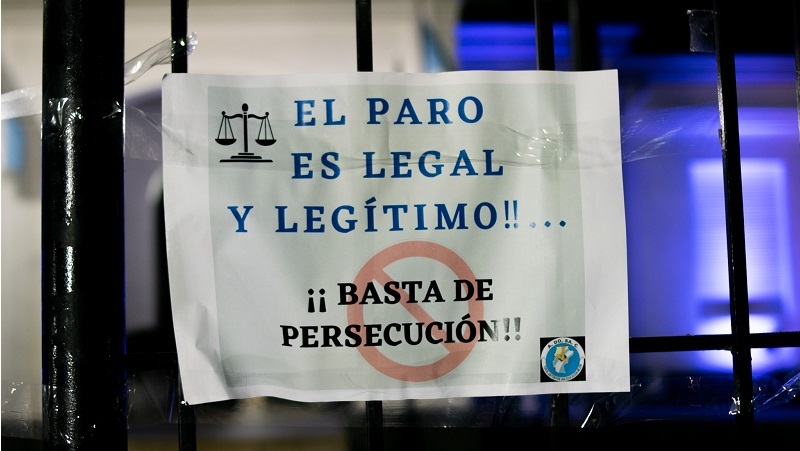
Teacher conflicts in Santa Cruz have a long historyand perhaps it can be summarized in some key years, where there were burning moments in the fight for better wages, labor, investment in public education and against the attacks that the ADOSAC union has suffered during the more than 30 years of Kirchner governments.

2007 and 2011, years of historic struggles
may be mentioned the enormous mobilizations of 2007, with camps and massive support from other sectors of the public administration that, despite the militarization of Río Gallegos, led to a victory for the teachers’ struggle and the resignation of the governor of the Frente Para la Victoria Carlos Sancho. On April 12, 2011, while a group of teachers were handing out pamphlets on the outskirts of the town of 28 de Noviembre, they were savagely attacked by a UOCRA gang that was accompanying Governor Daniel Peralta.. There was enormous repudiation from a large part of the community and Governor Peralta was declared “Persona non grata” in the Río Turbio coal basin. Instead, there was an absolute silence from Kirhcnerism and even those responsible for the construction union went unpunished. The struggle ended with a harsh repression in the Ministry of Labor of the Autonomous City of Buenos Aires, on June 24 of that year.. The provincial government applied massive discounts to the teachers who were part of the force measures.

2016, a year of great teacher mobilizations and Alicia Kirchner as Macri’s best student
The last two major conflicts were in 2016 and 2017. Alicia Kirchner had taken office as governor and was paying late and in installments, the salaries of public administration workers. There were camps of teaching, judicial and retired workers in various ministries of the provincial government. At the national level, Mauricio Macri was the president of the country and the governor of Santa Cruz, became the best student of a fiscal adjustment that subjected workers to a severe drop in their salaries, from which they have not yet recovered.
2017, a year of low wages, camps and repression
There were two particular events. The first was not complying with the mandatory conciliation that the province’s Ministry of Labor tried to impose on the teachers’ union so many times. In this way, Alicia Kirchner tried to weaken the teachers’ struggle, but to no avail. On April 21, Cristina Fernández had come to visit Río Gallegos. During the night, she met with her sister-in-law, Governor Alicia Kirchner, at the Casa de la Gobernación. Up to there hundreds of workers went to demand that they be paid in due time and form their owed wages. Around the building there were songs of repudiation of the provincial government. Almost at midnight, a group of protesters entered the garden of the Casa de la Gobernación. As the protest seemed to end, the police infantry quickly arrived to brutally repress those who were there. La Izquierda Diario was covering it live, while the police fired tear gas and rubber bullets. A photographer who was covering the demonstration was injured by the repression.
Testimonies of those who were repressed on April 21, 2017, in the House of the Governor of Río Gallegos
The next day the campaign began with Cristina Fernández and Alicia Kirchner as witnesses and assuming themselves as victims of an alleged premeditated attack by a group of conspirators who never existed. Months later, the accusations of the Provincial Justice arrive at references of teaching and public administration such as Juan Manuel Valentín, Claudio Wasquín, Diego Barrionuevo and Gabriela Ance (two are militants of the Partido Obrero). The cover applied against the defendants was “violation of residence”, and a prosecution until the start of the trial that until now has no date. Supposedly “they had incited to enter the garden”, but the evidence was never corroborated.

2022, year of millionaire fines against ADOSAC
In April 2022, Judge Francisco Marinkovic (closely allied to the provincial government), fined ADOSAC a total of 32 million pesos, for not complying with the mandatory conciliation of 2017. The teachers’ union argued that it was the government of Alicia Kirchner who was failing to comply, when she did not pay her salary in a timely manner. They even paid salaries in installments, causing serious banking problems for public administration workers.
2023 year of decrees, illegality and attempted imprisonment
This year there was another breakthrough in the provincial government’s attacks on ADOSAC. On April 11, the Santa Cruz Ministry of Labor declared the teachers’ strike illegal for refusing to accept an insufficient salary increase, which barely reaches 150 thousand pesos. According to studies carried out by the union itself, the Total Basic Basket reaches 220 thousand pesos. However, the Provincial Council of Education, with its minister Cecilia Velázquez said in the press that “the teacher’s salary in Santa Cruz is the best in the country.” Of course, the forceful measures continued despite the fact that on June 16, Alicia Kirchner decided to impose a salary increase by decree, abruptly closing the parities.
On June 30, the attacks against ADOSAC and teaching escalated seriously, when The Criminal Oral Chamber accepted the change of cover from “attempted violation of residence” to “attempted femicide and homicide”, requested by the surrogate prosecutor Federico Heinz. Such a change may allow for the imprisonment of teachers Juan Manuel Valentín, Claudio Wasquín, Diego Barrionuevo, plus the state worker Gabriela Ance. Governor Alicia Kirchner and current vice president Cristina Fernández are falsely accused of attempted murder, simply because they are women, in the demonstration on April 21, 2017. The accusation lacks conclusive evidence and the main witnesses are the governor herself and the vice president

Before the change of cover there was a repudiation of numerous human and social rights organizations, trade union organizations, left-wing parties and student centers. They consider that it is a serious precedent that seeks to criminalize social protest in Santa Cruz and prevent workers from going out to fight for fair claims. The lawyer for the teachers’ union, Enrique Papa, was categorical, saying “If they are accused of aggravated homicide, as is the case with femicide, there must be an intention to kill for being a woman, which clearly did not exist. This is the total and absolute trivialization of the fight of women against gender violence”.
the last attack
Last July 4 was the last attack on the teachers’ struggle. The Official Public Defender of Girls, Boys and Adolescents No. 1, demanded the return to classes and the Provincial Justice gave rise to ordering ADOSAC and the teaching staff to return to the classroom. Otherwise, fines, absenteeism and possible dismissals would begin for those who continue to be unemployed. After the repercussion in the national media, with data that describes that Santa Cruz is the province with the fewest classes, so far this year. There was a 60-day strike and that could hurt electorally the future pro-government governor and successor to Alicia Kirchner and her Unión por la Patria coalition.
The lawyer Enrique Papa, repudiated the opinion and will resort to the Supreme Court of Justice, but it is known that the times of justice can be eternal and it will be difficult to resolve in favor of the teacher’s claims. At the end of the first week of July, what is happening with the teachers’ struggle in Santa Cruz began to have repercussions in various national media.
Justice, the Ministry of Labor and the Provincial Council have always been accomplices of the government of Alicia Kirchner. They sought tools to subdue the claims and measures of force, trying to weaken the only union that did not submit, nor did it become an accomplice to the low wages granted by the provincial government.
Data kills stories
According to the report of the “Provincial Educational Financing” of the Observatory of Argentines for Education for the period 2004-2021, half of the provinces reduced investment in public education.
Santa Cruz, is the second with the lowest budget allocated to education, barely 17.6% of its provincial resources. It is no coincidence then that there were several complaints from ADOSAC for lack of heating in winter, lack of maintenance of school buildings, scarce teaching materials and also adding teacher salaries that do not exceed the poverty line.

In a speech last year, Cristina Fernández said that “Santa Cruz is part of the group of the nine provinces with the highest income in dollars, from mining.” She also added that, if compared by number of inhabitants, it is the first province to have more income in dollars, from the export of gold and silver. It must be clarified that the royalties paid by mining companies are the paltry 1.5%. Even so, the provincial government has resources to pay for a better education, with better salaries and reverse the fall in investment in public education. But it is not essential for Kirchnerism.

The Provincial Congress of ADOSAC will resolve how to continue with the claims and how to reverse the latest rulings of the provincial justice. There is no doubt that there was always cruelty against the education workers in Santa Cruz. Governor Alicia Kirchner seeks to imprison four leading workers in the fight against a salary adjustment, while at the national level she repudiated the repression suffered in Jujuy, the educational community, the native peoples and the people in general. Here in the province it also persecutes those who go out to fight, with dozens and dozens of accused teachers, miners, oil workers, unemployed, municipal and retirees. Several times they were repressed or suffered police brutality, but there the Provincial Justice leaves the complaints of those who suffered it in absolute impunity. It is not an isolated case of union persecution, it is a systematic history of continuous attacks on workers’ struggles in distant Patagonia, as is the case with teachers who do not want to live below the poverty line.
Source: www.laizquierdadiario.com

